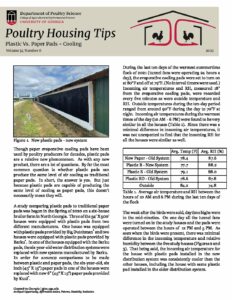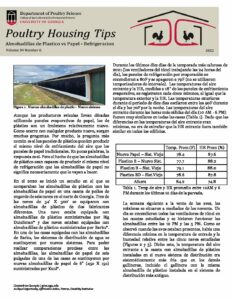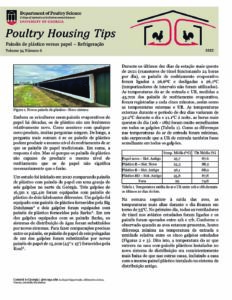Though paper evaporative cooling pads have been used by poultry producers for decades, plastic pads are a relative new phenomenon. As with any new product, there are a lot of questions. By far the most common question is whether plastic pads can produce the same level of air cooling as traditional paper pads. In short, the answer is yes. But just because plastic pads are capable of producing the same level of cooling as paper pads, this doesn’t necessarily mean they will.
A study comparing plastic pads to traditional paper pads was begun in the Spring of 2020 on a six-house broiler farm in North Georgia. Three of the 54' X 500' houses were equipped with plastic pads from two different manufacturers. One house was equipped with plastic pads provided by Big Dutchman* and two houses were equipped with plastic pads provided by Barku*. In one of the houses equipped with the Barku pads, the six-year-old water distribution systems were replaced with new systems manufactured by Barku. In order for accurate comparisons to be made between plastic and paper pads, the six-year-old, six inch (45o X 15o) paper pads in one of the houses were replaced with new 6" (45o X 15o) paper pads provided by Kuul*.
During the last ten days of the warmest summertime flock of 2021 (tunnel fans were operating 24 hours a day), the evaporative cooling pads were set to turn on at 80oF and off at 79oF. (No interval timers were used.) Incoming air temperatures and RH, measured 18" from the evaporative cooling pads, were recorded every five minutes as were outside temperature and RH. Outside temperatures during the ten-day period ranged from around 90oF during the day to 70oF at night. Incoming air temperatures during the warmest times of the day (10 AM - 6 PM) were found to be very similar in all the houses (Table 1). Since there was a minimal difference in incoming air temperatures, it was not unexpected to find that the incoming RH for all the houses were similar as well.
Avg. Temp (F) Avg. RH (%)
New Paper - Old System 78.4 87.6
Plastic B - New System 77.7 88.2
Plastic B - Old System 79.1 88.0
Plastic BD - Old System 78.6 87.8
Outside 84.2 74.8
Table 1. Average air temperature and RH between the hours of 10 AM and 6 PM during the last ten days of the flock
The week after the birds were sold, daytime highs were in the mid-nineties. On one day all the tunnel fans were turned on in the study houses and the pads were operated between the hours of 12 PM and 5 PM. As seen when the birds were present, there was minimal difference in the incoming temperature and relative humidity between the five study houses (Figures 2 and 3). That being said, the incoming air temperature for the house with plastic pads installed in the new distribution system was consistently cooler than the other houses, including the house with same plastic pad installed in the older distribution system.
It is important to keep in mind that since plastic pads do not wick water like paper pads, they are more difficult to throughly wet and as a result are prone to produce less cooling than paper pads. The wicking action of paper pads is often underappreciated. If a distribution pipe hole or two are clogged or a circulation pump is not circulating the proper amount of water, the entire pad area will still tend to be wet due to water moving from the wet areas of pad to the dry areas. You have probably seen the wicking nature of paper pads in action when the bottom of the pad is sitting on an overfilled reservoir pipe and the bottom six to twelve inches of the pad is wet even though the circulation pump is off. Since there is essentially no wicking action with plastic evaporative cooling pads, it is crucial that the water distribution system is delivering as much water as possible to all pad surfaces.
Wherein the past the farm manager would partially close the valve above the circulation pump to keep water from spraying out the top of the distribution system to a minimum, the valves above were opened fully. This was necessary because during preliminary testing it was discovered that when the valves were partially closed, portions of the plastic pads remained dry, which resulted in a reduction in cooling. Though fully opening the valves did result in significant water wastage in the houses with the older distribution systems, it was deemed necessary in order to determine the maximum cooling ability of the plastic pads.
One of the key differences between the new distribution system and the older distribution systems on the farm was that the circulation pump in the new system was capable of circulating roughly twice the volume of water. An equally important difference was that distribution system cover was cable of focusing the increased volume of water onto the top of the pads with little to no water wastage. The ability of the new distribution system to deliver roughly twice the water to the pads very likely contributed to the slightly greater cooling produced by the plastic pads installed in the new distribution systems than those pads in the older distribution systems. Had all distribution systems been replaced, the slight cooling differences observed between the study houses may have been different.
To date, the field study has demonstrated that plastic pads are capable of producing similar cooling to traditional paper pads. The lack of wicking action makes plastic pads more difficult to throughly wet compared to paper pads, which may result in reduced cooling in certain situations. Having a distribution system capable of efficiently circulating a large volume of water over plastic pads will help insure that they produce the necessary level of cooling to keep birds comfortable during hot weather.
Authors:
Michael Czarick
Department of Poultry Science - UGA
Brian Fairchild
Department of Poultry Science - UGA
poultryventilation.com
*Trade and brand names are used only for information. The Cooperative Extension Service, The University of Georgia College of Agriculture and Environmental Sciences does not guarantee nor warrant the standard of any product mentioned; neither does it imply approval of any products to the exclusion of others that may also be suitable.
ATTACHMENTS
Details
| Year | Volume | Number | Categories |
|---|---|---|---|
| 2022 | 34 | 6 |



